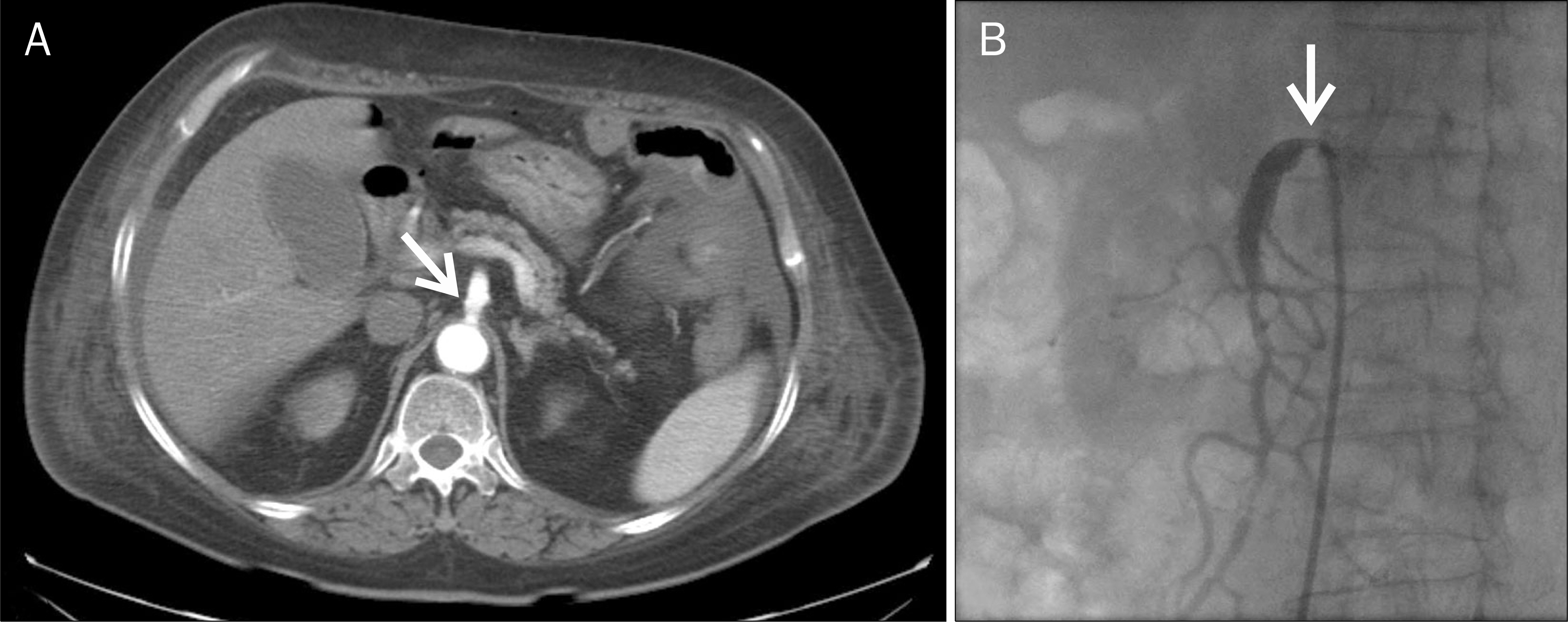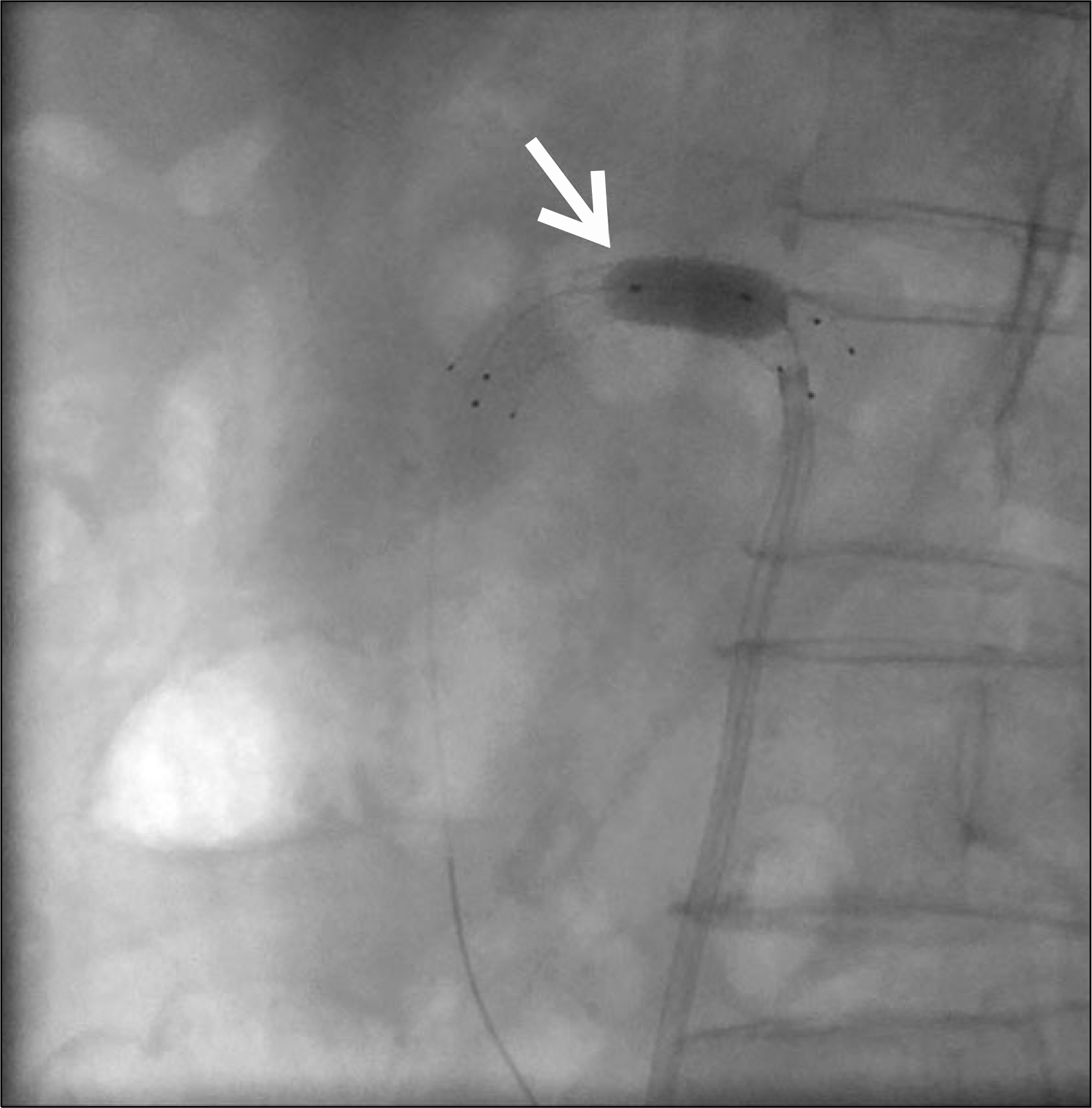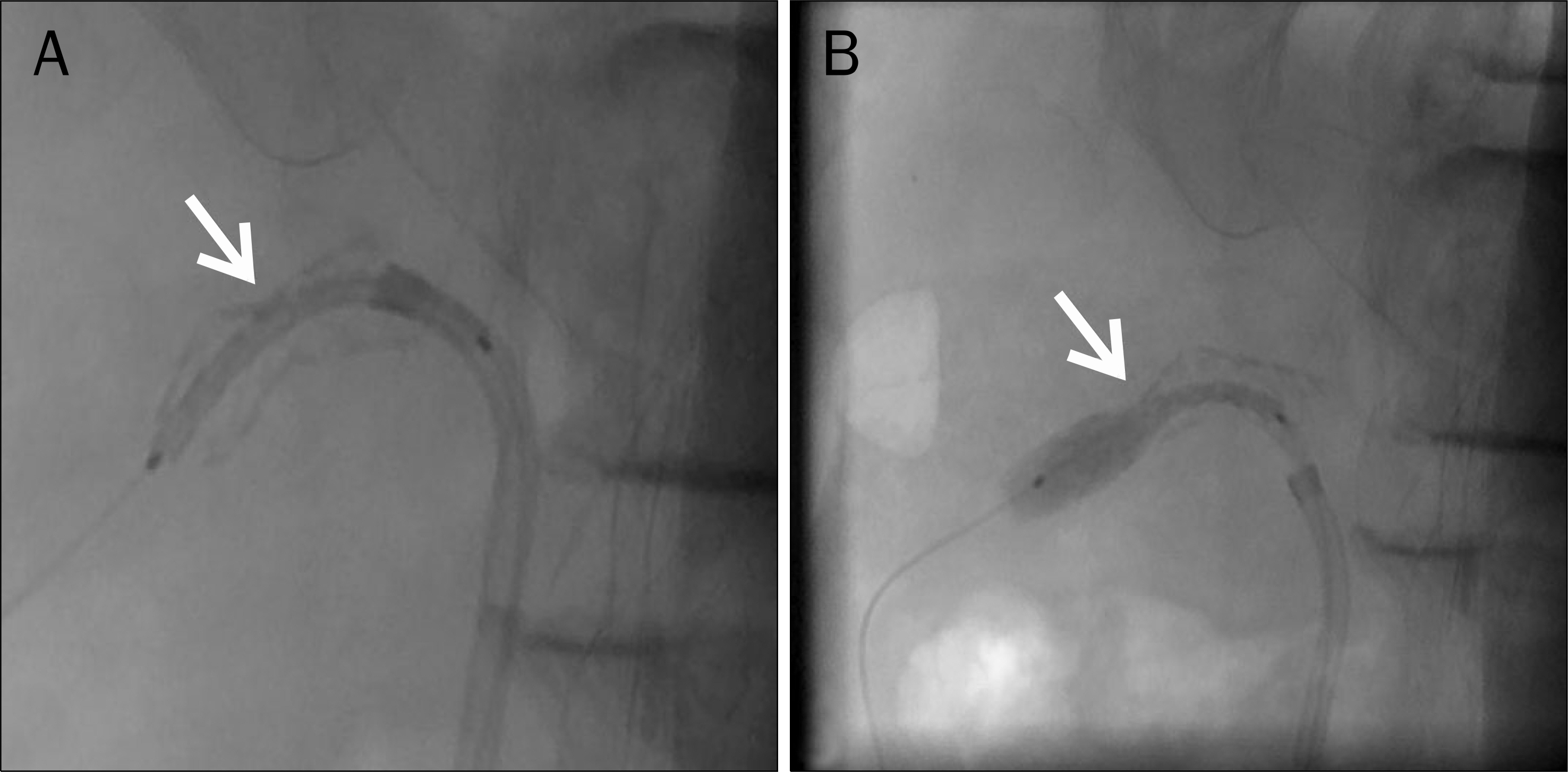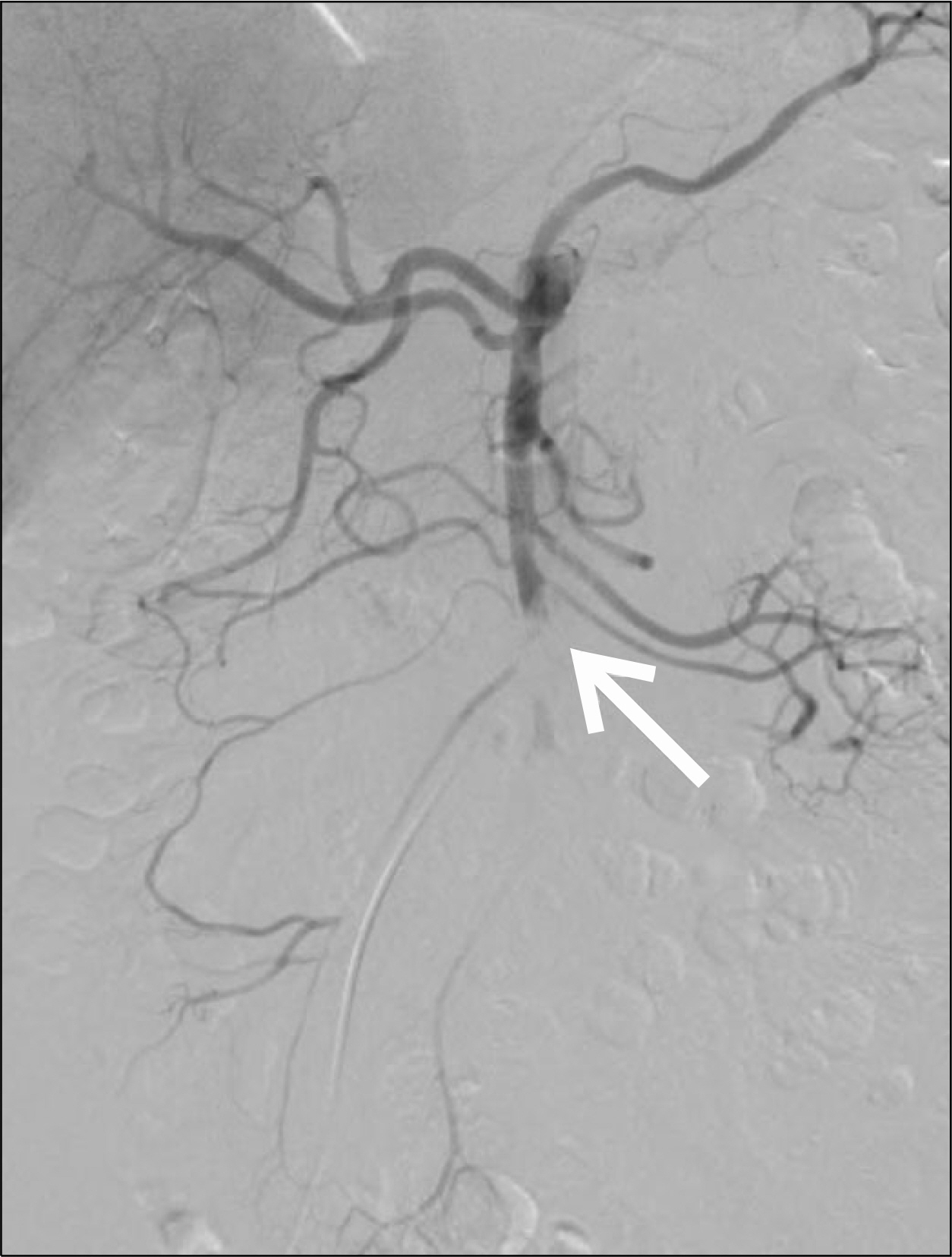Korean J Gastroenterol.
2011 Apr;57(4):243-248. 10.4166/kjg.2011.57.4.243.
Clinical Effectiveness of Percutaneous Angioplasty for Acute and Chronic Mesenteric Ischemia: A Six Case Series
- Affiliations
-
- 1Department of Internal Medicine, Eulji University School of Medicine, Seoul, Korea. jyj1138@eulji.ac.kr
- 2Department of Radiology, Eulji University School of Medicine, Seoul, Korea.
- KMID: 1718405
- DOI: http://doi.org/10.4166/kjg.2011.57.4.243
Abstract
- Intestinal ischemia is divided into three categories, namely, acute mesenteric ischemia (AMI), chronic mesenteric ischemia (CMI), and colonic ischemia. AMI can result from arterial or venous thrombi, emboli, and vasoconstriction secondary to low-flow states. It is an urgent condition which can result in high mortality rate. The predominant causative factor of CMI is stenosis or occlusion of the mesenteric arterial circulation, and it is characterized by postprandial abdominal pain and weight loss. Surgery is the treatment of choice for intestinal ischemia. However, it has been recently reported that percutaneous transluminal angioplasty with stent placement and/or thrombolysis is an effective therapy in various types of mesenteric ischemia. We report six cases of mesenteric ischemia which were successfully treated by percutaneous angioplasty, and review the literature from South Korea.
Keyword
MeSH Terms
Figure
Reference
-
References
1. Lim RP, Dowling RJ, Thomson KR. Angioplasty and stenting of the superior mesenteric artery in acute mesenteric ischaemia. Australas Radiol. 2004; 48:426–429.
Article2. Howard TJ, Plaskon LA, Wiebke EA, Wilcox MG, Madura JA. Nonocclusive mesenteric ischemia remains a diagnostic dilemma. Am J Surg. 1996; 171:405–408.
Article3. Chandra A, Quinones-Baldrich WJ. Chronic mesenteric ischemia: how to select patients for invasive treatment. Semin Vasc Surg. 2010; 23:21–28.
Article4. Kougias P, Lau D, El Sayed HF, Zhou W, Huynh TT, Lin PH. Determinants of mortality and treatment outcome following surgical interventions for acute mesenteric ischemia. J Vasc Surg. 2007; 46:467–474.
Article5. Gupta R, Chimpiri AR, Saucedo JF. Superior mesenteric artery thrombosis managed percutaneously by timely combining aspiration thrombectomy with angioplasty and stents. J Thromb Thrombolysis. 2010; 29:105–107.
Article6. Schermerhorn ML, Giles KA, Hamdan AD, Wyers MC, Pomposelli FB. Mesenteric revascularization: management and outcomes in the United States, 1988–2006. J Vasc Surg. 2009; 50:341–348. e1.
Article7. Zacho HD, Abrahamsen J. Functional versus radiological assessment of chronic intestinal ischaemia. Clin Physiol Funct Imaging. 2010; 30:116–121.
Article8. Gweon HM, Suh SH, Won JY, Lee DY, Kim SS. Percutaneous stenting of the superior mesenteric artery for the treatment of chronic mesenteric ischemia. J Korean Radiol Soc. 2008; 58:571–578.
Article9. Moon IS, Kwon OS, Jung HS, et al. A case of chronic mesenteric ischemia treated with percutaneous transluminal angioplasty. Korean J Gastroenterol. 2003; 41:499–503.10. Kim JH, Ahn S, Shim WH. A case report of percutaneous transluminal angioplasty with stenting in treatment of superior me-genteric artery stenosis. Korean Circ J. 1997; 27:228–233.11. Kim MH, Lee DY, Han KH, et al. A case of superior mesenteric artery thrombosis treated with intraarterial urokinase infusion and intraluminal stent insertion. Korean J Gastroenterol. 2001; 37:132–136.12. Go BS, Lee JH, Nam HK, et al. A case of mesenteric ischemia in a patient who was on continuous ambulatory peritoneal dialysis. Korean J Med. 2006; 71(Suppl 3):S1073–S1078.13. Kim JH, Cheon GJ, Choi TH, et al. Successful treatment of acute ischemic colitis with stent insertion. Korean J Med. 2005; 69:686–691.14. Cluzel P, Auguste M, Galvez V. Traitement endovasculaire des arteres digestives. Kieffer E, Parc EA, editors. Chirurgie des arteres digestives. Paris: 1999. p. 145–153.15. Mateo RB, O'Hara PJ, Hertzer NR, Mascha EJ, Beven EG, Krajewski LP. Elective surgical treatment of symptomatic chronic mesenteric occlusive disease: early results and late outcomes. J Vasc Surg. 1999; 29:821–831.
Article16. Johnston KW, Lindsay TF, Walker PM, Kalman PG. Mesenteric arterial bypass grafts: early and late results and suggested surgical approach for chronic and acute mesenteric ischemia. Surgery. 1995; 118:1–7.
Article17. Oderich GS, Gloviczki P, Bower TC. Open surgical treatment for chronic mesenteric ischemia in the endovascular era: when it is necessary and what is the preferred technique? Semin Vasc Surg. 2010; 23:36–46.
Article18. Dias NV, Acosta S, Resch T, et al. Midterm outcome of endovascular revascularization for chronic mesenteric ischaemia. Br J Surg. 2010; 97:195–201.
Article19. Edwards MS, Cherr GS, Craven TE, et al. Acute occlusive mesenteric ischemia: surgical management and outcomes. Ann Vasc Surg. 2003; 17:72–79.
Article20. Wyers MC. Acute mesenteric ischemia: diagnostic approach and surgical treatment. Semin Vasc Surg. 2010; 23:9–20.
Article
- Full Text Links
- Actions
-
Cited
- CITED
-
- Close
- Share
- Similar articles
-
- A Case of Chronic Mesenteric Ischemia Treated with Percutaneous Transluminal Angioplasty
- A Case Report of Percutaneous Transluminal Angioplasty with Stenting in
- A novel hybrid technique to treat flush mesenteric arterial occlusion in acute-on-chronic mesenteric ischemia
- Percutaneous Stenting of the Superior Mesenteric Artery for the Treatment of Chronic Mesenteric Ischemia
- A Case of Spontaneous Dissection of the Superior Mesenteric Artery Treated by Percutaneous Stent Placement





